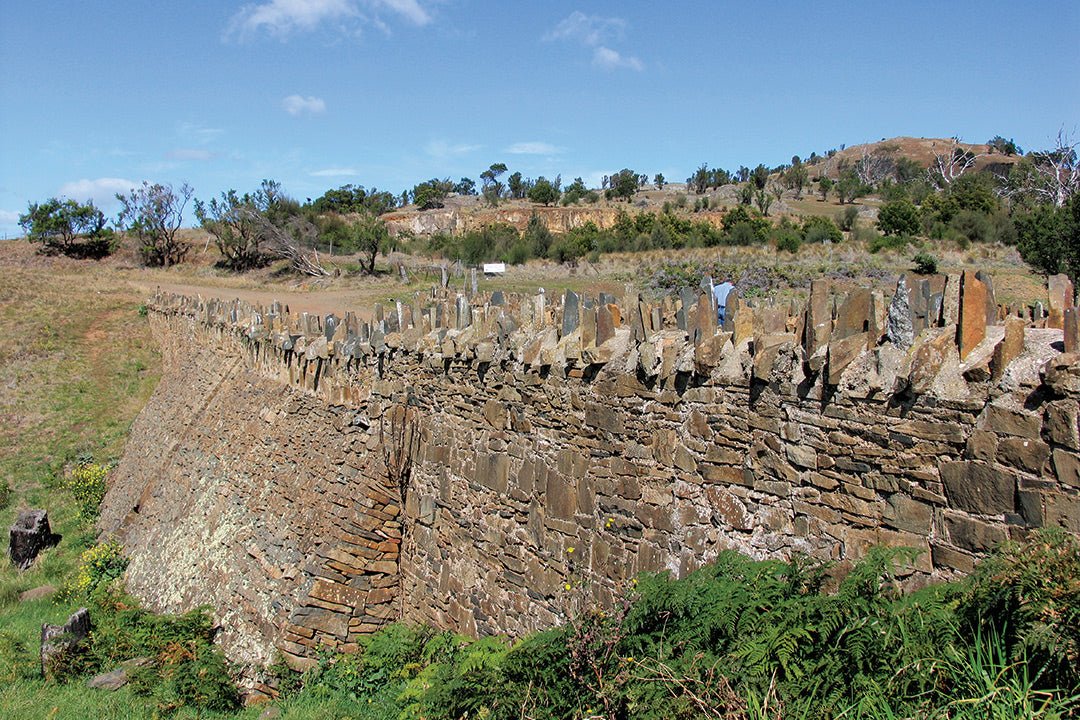Spiky Bridge | A quirky attraction on Tasmania's east coast

Just over 7km south of Swansea on the east coast of Tasmania is Spiky Bridge, a curious relic of the convict era and one of many convict-built bridges on the Apple Isle.
Listed on the Tasmanian Heritage Register, Spiky Bridge was built by convicts in 1843 and forms part of the convict-built coach road which connected Swansea to Little Swanport and the east coast road to Hobart. With the bridge’s location opposite the beaches of Great Oyster Bay (a beautiful place to visit once you've ticked the bridge off your bucket list), you need to be careful you don’t miss the turnoff while admiring the ocean views.
The bridge was built from local fieldstones without mortar or cement, and a small arch allows water to pass beneath. The parapet was constructed using jagged field stones placed vertically on their ends, the simple method creating the spiky appearance — hence the bridge's name 'Spiky Bridge'.

Looking at the bridge’s side profile, you can see a water channel running down the wall from a slot at the base of the roadway and leading to the arch beneath the bridge, which allows water to drain off the road.
By the 1820s early European settlement was pushing northwards along Tasmania’s east coast from Hobart, drawn to the area by farming and whaling. Workers were not abundant in the area until the Rocky Hills Probation Station was constructed in 1841, providing free convict labour to build roads and bridges, clear land and construct station buildings, including the prison.
The reason why the bridge was decorated with these upright stones is the subject of speculation. One theory says it was to stop cattle falling into the gully or to prevent suicide jumpers. Another suggests that the convicts building the bridge used it as a form of revenge. It is questionable how they could do this while under supervision. Either way, the Spiky Bridge is now a curious stopping point for tourists.

Popular history says the bridge was built after Irishman Edward Carr Shaw of Redbanks gave his friend Major de Gillern, the superintendent of the Rocky Hills Probation Station, a ride home one night after a game of piquet (pee-kay). Shaw had repeatedly requested that improvements be made to the road between Swansea and Little Swanport, particularly the steep gully south of Swansea. His requests had evidently fallen on deaf ears, so to prove his point Shaw drove his gig and his passenger, the Major, through the gully at full gallop. It must have been a thoroughly uncomfortable trip because the bridge was erected shortly afterwards.
Initially the bridge was called Lafarelles Bridge after surveyor and civil engineer Thomas Lafarelle, who was the assistant superintendent at Rocky Hills Probation Station between 1843 and 1845 and who probably supervised the building of the bridge. On the nearby hill overlooking the bridge are the remains of the Governor’s cottage.
The Rocky Hills Probation Station only lasted eight years, coming to an end during an economic depression in the late 1840s. Under the convict probation system during the 1840s, all convicts had to serve time in a government work gang. Previously, convicts had been assigned to work for private settlers when they first arrived in the colony, clearing land and planting crops.
Swansea is Tasmania’s oldest seaside town. It was first settled in the 1820s by the Welsh, who named it Waterloo Point. It was renamed Swansea in 1842.
This isn't the only convict-built bridge in Tasmania. Richmond Bridge, 25km north of Hobart and built in 1825, is Australia’s oldest surviving large stone arch bridge.

THE NEXT STEP
If you want to learn the latest caravan news, find the most innovative new caravans and camping gear or get inspired to plan your next road trip to some of Australia's best getaway destinations and spectacular scenery, subscribe to our weekly newsletter. We promise to send you only the best content.







